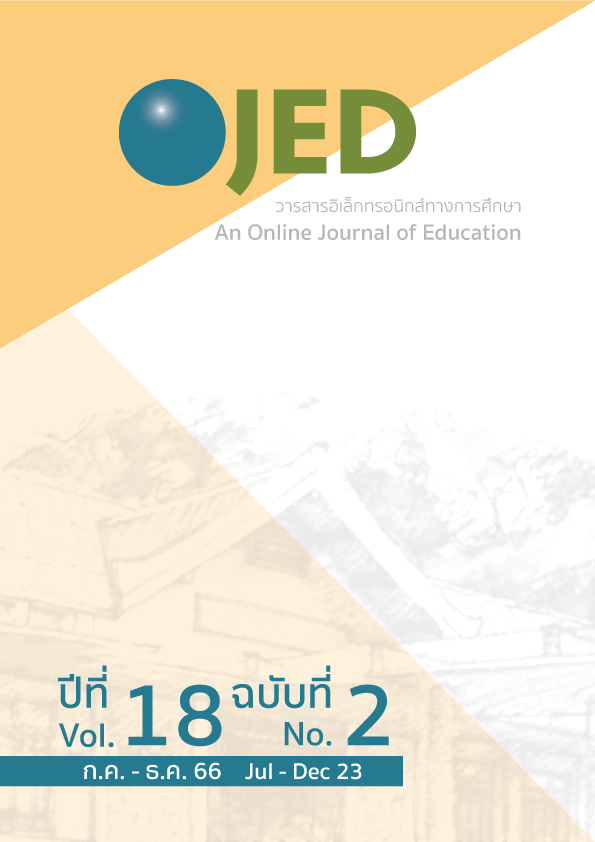Effects of Instruction Using Rhetorical and Collaborative Writing Approaches on the Creative Writing Abilities of Upper Secondary School Students
DOI:
https://doi.org/10.14456/ojed.2023.22Keywords:
creative writing abilities, rhetorical approach, collaborative writing approachAbstract
The objectives of this research were to: 1) compare the creative writing abilities of students before and after using rhetorical and collaborative writing approaches, and 2) study the improvement in the creative writing abilities of students using these approaches. The sampling group consisted of 21 grade 11 students of a large secondary school under the jurisdiction of the Secondary Educational Service Area Office Bangkok 1. The research instruments were an achievement test for evaluating creative writing abilities and lesson plans based on rhetorical and collaborative writing approaches. The data were analyzed using mean, standard deviation, t-test, and content analysis. The findings showed that: 1) the students who studied using rhetorical and collaborative writing approaches had average post-test scores, both overall and in terms of four components content, rhetoric, organization of ideas, and awareness of readers, that were significantly higher than their pre-test scores at the .05 level of significance; 2) through analyzing the students’ improvements in creative writing ability from five types of essays, namely essay, perspective writing, 2 types of persuasive writing and argumentative writing the students showed improved creative writing ability after using rhetorical and collaborative writing approaches.
References
ภาษาไทย
กระทรวงศึกษาธิการ. สำนักงานคณะกรรมการการศึกษาขั้นพื้นฐาน. (2552). หลักสูตรแกนกลาง
การศึกษาขั้นพื้นฐาน พุทธศักราช 2551. โรงพิมพ์ชุมนุมสหกรณ์การเกษตรแห่งประเทศไทย.
กระทรวงศึกษาธิการ. สำนักงานคณะกรรมการการศึกษาขั้นพื้นฐาน. สำนักวิชาการและมาตรฐาน
การศึกษา. (2553). แนวปฏิบัติการวัดและประเมินผลการเรียนรู้ตามหลักสูตรแกนกลางการศึกษาขั้นพื้นฐาน พุทธศักราช 2551. (พิมพ์ครั้งที่ 2). โรงพิมพ์ชุมนุมสหกรณ์การเกษตรแห่งประเทศไทย.
ถวัลย์ มาศจรัส. (2545). การเขียนเชิงสร้างสรรค์เพื่อการศึกษาและอาชีพ. ธารอักษร.
พัฒนา ขุนอินทร์. (2564). การพัฒนาทักษะการเขียนเชิงสร้างสรรค์ วิชาภาษาไทยของนักเรียนชั้นมัธยมศึกษาปีที่ 4 ปีการศึกษา 2564. [รายงานวิจัยในชั้นเรียน, แคมป์สนวิทยาคม] . filesthaischool0.com/files/uppic/
/news/67100685_1_20211020-112745.pdf
ภาคภูมิ หรรนภา. (2544). การเขียนเพื่อการสื่อสาร. อินทนิล.
วัชรพล วิบูลยศริน. (2556). การพัฒนารูปแบบการเรียนการสอนแบบผสมผสานตามแนวการสื่อสารแบบมีส่วนร่วมโดยใช้เทคนิคการเขียนรอบวงบนสื่อสังคมเพื่อเสริมสร้างความสามารถด้านการเขียนวิพากษ์เชิงสร้างสรรค์สำหรับนักศึกษาปริญญาตรี. ปริญญาครุศาสตรดุษฎีบัณฑิต สาขาวิชาเทคโนโลยีและการสื่อสาร คณะครุศาสตร์ จุฬาลงกรณ์มหาวิทยาลัย.
วัชรพล วิบูลยศริน. (2561). วิธีวิทยาการจัดการเรียนรู้ภาษาไทย (methodology of Thai
language learning management). สำนักพิมพ์แห่งจุฬาลงกรณ์มหาวิทยาลัย.
อดุลย์ ไทรเล็กทิม. (2549). ปัญหาการใช้ภาษาไทยของนักเรียนชั้นมัธยมศึกษาในกรุงเทพมหานคร.
ภาควิชาหลักสูตรและการสอน มหาวิทยาลัยรามคำแหง.
ภาษาอังกฤษ
Adsit, J. (2018). Creative writing and the limits of Naming What We Know: threshold concepts from aesthetic theory and creativity studies in the literary writing curriculum. New Writing, 15(2), 131-139, DOI: 10.1080/14790726.2017.1324881
Fletcher, J. (2015). Teaching argument: Rhetorical comprehension, critique, and resp Foreword by Carol Jago. Stenhouse Publishers.
Khany et al. (2019). A model of rhetorical markers competence in writing academic research articles: a qualitative meta-synthesis. Asian-Pacific Journal of Second and Foreign Language Education, 4(1), doi.org/10.1186/s40862-018-0064-0
Klein, P. D., Haug, K. N., & Arcon, N. (2017). The Effects of Rhetorical and Content Subgoals on Writing and Learning. The Journal of Experimental Education, 85(2), 291-308, DOI: 10.1080/00220973.2016.1143795
Lowry, P.b., Crutis, A, & Lowry, M. R. (2004). Building a taxonomy and nomenclature of collaborative writing to improve interdisciplinary research and practice. Journal of Business Communication. 41(1), 66-99.
Rbuiaee, A. A. M., Darus, S. A, & Bakar, N. A. (2015). Collaborative writing: A review of definitions from past studies. ResearchGate. 138-149.
Soraya, K. (2016). The effectiveness of collaborative writing strategy (CWS) in writing lessons regarded to the students’ creativity. Lingua Cultura. 10(2), 63-67, doi: 10.21512/lc.v10i2.898
Storch, N. (2005). Collaborative writing: Product, process, and students’ reflections. Journal of Second Language Writing. 14, 153-173.
Veramuthu, P., & Shah, P. M. (2020). Effectiveness of collaborative writing among secondary school student in an ESL classroom. Creative Education.11,54-67. doi:10.4236/ce.2020.111004
Downloads
Published
How to Cite
Issue
Section
License
Copyright (c) 2023 An Online Journal of Education

This work is licensed under a Creative Commons Attribution-NonCommercial-NoDerivatives 4.0 International License.




